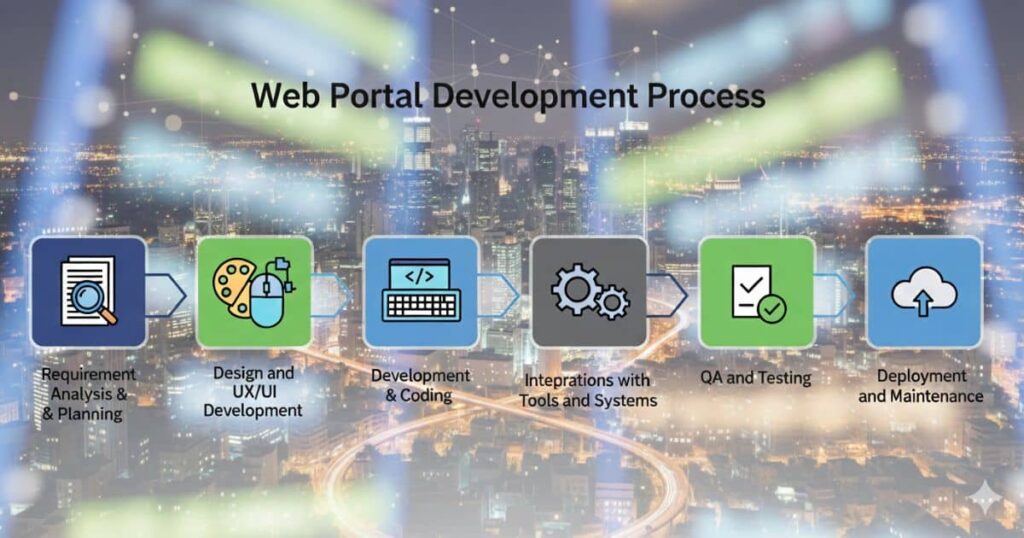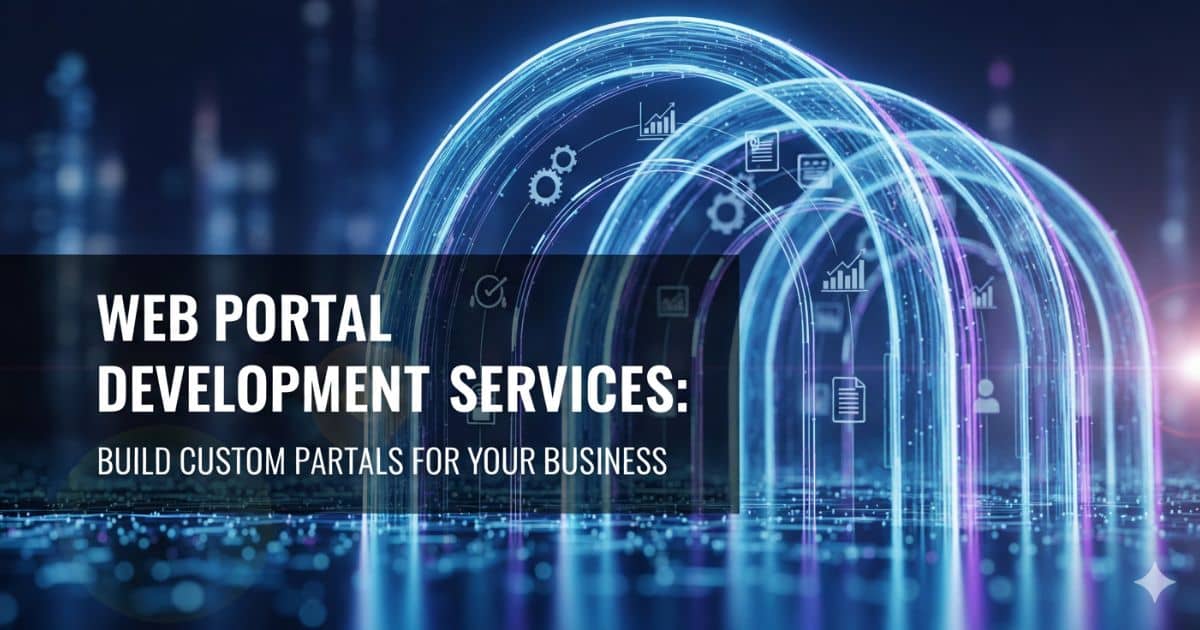Table of contents:
What is a Web Portal?
Definition and Purpose
Websites vs Web Portals
Self-Service Portals
Customer Portals
Vendor Portals
Partner Portals
Employee Portals
Patient Portals
eLearning Portals
Government Portals
Community Portals
Requirement Analysis and Planning
Design and UX/UI Development
Development and Coding
Integrations with Tools and Systems
QA and Testing
Deployment and Maintenance
Front-End Technologies
Back-End Technologies
Databases and Cloud Platforms
Real-Time Data Processing
Businesses today need more than just a static website. They need platforms that offer personalized experiences, secure access to data, and seamless interaction between different user groups. This is where web portal development comes into play.
A web portal is a unified digital platform that connects users, employees, customers, or partners to relevant information and services. Unlike a standard website that simply displays information, a portal provides interactive features, user authentication, and personalized dashboards. Professional Web portal development services help businesses create secure, scalable platforms that streamline operations and improve user engagement.
Whether you need a customer portal, employee portal, or vendor management system, investing in custom portal software development gives you a competitive edge. It centralizes your data, automates workflows, and creates a better experience for everyone who interacts with your business.
What is a Web Portal?
Definition and Purpose
A web portal is a secure, interactive platform that provides users with centralized access to information, applications, and services tailored to their specific needs. Think of it as a digital gateway that brings together multiple resources in one place. Unlike regular websites that serve the same content to everyone, portals offer personalized experiences based on user roles and permissions.
Web portal software development focuses on creating platforms that facilitate communication, collaboration, and data sharing. Companies use these portals to connect with customers, manage internal teams, coordinate with vendors, or serve specific communities. The goal is to make information easily accessible while maintaining security and control.
To explore where the industry is heading, check out our insights on web portal trends and future development.
Websites vs Web Portals
The key difference lies in interaction and personalization. A website is typically public-facing and informational. Anyone can visit and see the same content. A portal, on the other hand, requires authentication and delivers customized content based on who’s logged in.
Portals integrate with other business tools like CRM systems, databases, and third-party applications. They support two-way communication, document sharing, real-time updates, and collaborative workflows. For example, an employee portal might connect to your HR system, payroll software, and project management tools, giving staff everything they need in one secure location.
Different Types of Web Portals and Their Uses
Self-Service Portals
Self-service portals empower users to find answers and complete tasks without contacting support. Customers can track orders, update account information, download resources, or submit requests. This reduces the workload on your team while improving customer satisfaction.
Customer Portals
Customer portals strengthen relationships by providing clients with 24/7 access to their accounts. Users can view purchase history, manage subscriptions, access support documentation, and communicate directly with your team. These portals build trust and loyalty by putting control in the customer’s hands.
Vendor Portals
Vendor portals streamline supply chain management. Suppliers can submit invoices, track payments, update inventory information, and communicate with procurement teams. This transparency reduces errors and speeds up business processes.
Partner Portals
Partner portals facilitate collaboration with distributors, resellers, and business partners. Share marketing materials, sales data, training resources, and product updates through a secure platform. Partners get the information they need to represent your brand effectively.
Employee Portals
Employee portals serve as a central hub for internal communication and resources. Staff can access company policies, submit time-off requests, view pay stubs, complete training modules, and collaborate with colleagues. This improves engagement and operational efficiency.
Patient Portals
Healthcare providers use patient portals to improve care delivery. Patients can schedule appointments, view test results, request prescription refills, and communicate with healthcare teams. These portals enhance patient engagement while reducing administrative burden.
eLearning Portals
Educational institutions and training organizations use eLearning portals to deliver courses, track progress, and manage certifications. Students access course materials, submit assignments, participate in discussions, and monitor their academic performance.
Government Portals
Government agencies create portals to provide citizens with access to public services. Users can file applications, pay taxes, access records, and communicate with government offices. These portals improve service delivery and transparency.
Community Portals
Community portals bring together people with shared interests. Members can participate in forums, share content, organize events, and build connections. These platforms foster engagement and create value for specific user groups.
Custom Web portal development ensures your platform meets your unique requirements and delivers the best possible experience for your target audience.
Web Portal Development Process

Requirement Analysis and Planning
The first step involves understanding your business goals and user needs. What problems will the portal solve? Who will use it? What features are essential? This phase includes stakeholder interviews, workflow analysis, and defining technical requirements. Clear planning sets the foundation for success.
Design and UX/UI Development
Design focuses on creating intuitive interfaces that users find easy to navigate. Designers create wireframes, mockups, and prototypes that map out the user journey. The goal is to balance functionality with aesthetics. Good UX design reduces training time and increases adoption rates.
Development and Coding
Developers build the portal using front-end and back-end technologies. This phase involves iterative development with regular testing and feedback. Front-end developers create the user interface while back-end developers handle server logic, databases, and integrations. Portal development follows agile methodologies to ensure flexibility and quality.
Integrations with Tools and Systems
Modern portals don’t exist in isolation. They connect with CRM platforms, ERP systems, payment gateways, email services, and other business tools. Integration ensures data flows seamlessly between systems. For businesses using specialized software like ATS solutions, portal software development includes building custom connectors that sync recruitment data in real-time.
To learn how ATS technology is reshaping talent acquisition, explore our blog on Modern ATS and talent acquisition.
QA and Testing
Quality assurance teams test every feature to ensure functionality, performance, and security. This includes functional testing, load testing, security audits, and user acceptance testing. Identifying and fixing issues before launch prevents costly problems down the road.
Deployment and Maintenance
Once testing is complete, the portal goes live. Deployment includes setting up hosting, configuring security measures, and migrating data. Ongoing maintenance keeps the portal running smoothly with regular updates, performance monitoring, and technical support. Web portal services often include managed hosting and continuous improvement.
Tools and Technologies for Web Portal Development
Front-End Technologies
Modern portals use frameworks like Angular, React, and Vue.js to create responsive, interactive interfaces. These technologies enable smooth user experiences across desktop and mobile devices. Front-end developers use HTML5, CSS3, and JavaScript to bring designs to life.
Back-End Technologies
Back-end development powers the server-side logic. Popular choices include Python with Django or Flask, Node.js for JavaScript-based backends, Java for enterprise applications, and .NET for Microsoft environments. The technology choice depends on your specific requirements and existing infrastructure.
Databases and Cloud Platforms
Portals need robust databases to store and retrieve information efficiently. MySQL and PostgreSQL serve relational data needs, while MongoDB handles unstructured data. Cloud platforms like AWS, Azure, and Google Cloud provide scalable hosting solutions with built-in security and reliability.
Real-Time Data Processing
For portals requiring real-time updates, technologies like Apache Kafka, RabbitMQ, and Apache Flink handle data streaming and processing. These tools ensure users see the latest information without delays.
Perception System uses cutting-edge technologies to build high-performance portals that meet modern business demands.
Cost of Web Portal Development
Portal development costs typically range from $20,000 to $80,000, though complex enterprise portals can exceed this range. Several factors influence the final price:
Features and functionality: Basic portals with standard features cost less than platforms with advanced capabilities like AI-powered recommendations, real-time analytics, or complex workflow automation.
Integrations: Connecting your portal to existing systems requires additional development. The more integrations needed, the higher the cost.
Technology stack: Certain technologies and frameworks require specialized expertise, which can affect pricing.
Design complexity: Custom designs with unique branding and advanced UX elements require more design time.
Scalability requirements: Portals built to handle thousands of concurrent users need robust architecture, which increases development costs.
Security features: Enhanced security measures like multi-factor authentication, encryption, and compliance with regulations add to the investment.
Maintenance and support: Ongoing technical support, updates, and feature enhancements should be factored into your budget.
While website portal development represents a significant investment, the long-term benefits often justify the cost. Companies that implement Custom ats Software Development or similar specialized portals typically see ROI through improved efficiency and reduced operational costs.
Benefits of Web Portal Software Development
Improved User Experience: Portals provide personalized, role-based access to information. Users find what they need quickly without navigating through irrelevant content. This convenience increases satisfaction and engagement.
Centralized Access: All resources, documents, and tools live in one secure location. This eliminates the frustration of searching through multiple systems and reduces information silos within organizations.
Enhanced Communication: Portal solutions facilitate better communication between your business and stakeholders. Built-in messaging, notifications, and collaboration tools keep everyone connected and informed.
Streamlined Operations: Automation of routine tasks frees up your team to focus on strategic work. Self-service features reduce support tickets and administrative overhead.
Data-Driven Decisions: Advanced analytics and reporting capabilities provide insights into user behavior, operational metrics, and business performance. These insights drive smarter decision-making.
Scalability and Flexibility: Custom portals grow with your business. Add new features, integrate additional systems, and expand user capacity as needed without starting from scratch.
Better Security: Portals provide controlled access to sensitive information. Role-based permissions, encryption, and audit trails protect your data while ensuring the right people have access.
Increased Productivity: When employees, customers, or partners can easily access the tools and information they need, productivity increases. Less time spent searching means more time spent doing valuable work.
Competitive Advantage: A well-designed portal differentiates your business. It shows you value user experience and are willing to invest in tools that make interactions easier.
Customer Loyalty: When customers can manage their accounts, access support, and complete transactions easily, they’re more likely to remain loyal. Positive experiences lead to repeat business and referrals.
FAQ Section: Web Portal Development Services
What is web portal development?
Web portal development is the process of creating secure, interactive platforms that provide users with personalized access to information, applications, and services. These platforms serve specific user groups like customers, employees, or partners, offering features beyond what standard websites provide.
How long does it take to develop a web portal?
Development timelines vary based on complexity. A basic portal might take 2-3 months, while enterprise-grade platforms with advanced features can take 6-12 months or longer. Factors affecting timeline include feature requirements, integrations, design complexity, and testing needs.
What technologies are used for web portal software development?
Modern portals use a combination of technologies. Front-end frameworks like React, Angular, or Vue.js create user interfaces. Back-end languages include Python, Node.js, Java, or .NET. Databases like MySQL, PostgreSQL, or MongoDB store data. Cloud platforms like AWS or Azure provide hosting infrastructure.
How much does a custom web portal cost?
Custom portal development typically costs between $20,000 and $80,000, though prices vary based on specific requirements. Factors affecting cost include features, integrations, technology choices, design complexity, and ongoing maintenance needs. Complex enterprise portals may require larger investments.
Can web portals integrate with existing systems?
Yes, integration is a core capability of modern web portal solutions. Portals can connect with CRM systems, ERP platforms, payment processors, HR software, and various third-party applications through APIs. This ensures seamless data flow and unified operations.
Why should I choose a professional web portal development company?
Professional portal development companies bring expertise, best practices, and proven methodologies. They understand security requirements, scalability considerations, and user experience principles. Working with experienced developers ensures your portal is built right the first time, saving time and avoiding costly mistakes.
Conclusion
Professional web portal development services transform how businesses interact with customers, employees, and partners. These platforms offer more than just information—they create personalized experiences, streamline operations, and provide valuable insights through analytics.
Whether you need a customer portal to improve service delivery, an employee portal to boost internal communication, or a specialized platform for your industry, custom portal solutions offer the flexibility and scalability to meet your needs. The right portal development company understands your unique requirements and builds solutions that align with your business goals.
From initial planning through design, development, integration, and ongoing support, every phase of the portal development process contributes to creating a platform that delivers real value. The investment in quality portal software development pays dividends through improved efficiency, better user experiences, and competitive advantage.
Ready to build a custom portal for your business? Contact us to discuss how Perception System can help you create a powerful platform that meets your specific needs and drives business success.




